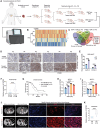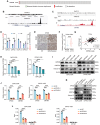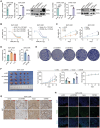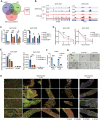Epigenetic Activation of the CMTM6-IGF2BP1-EP300 Positive Feedback Loop Drives Gemcitabine Resistance in Pancreatic Ductal Adenocarcinoma
- PMID: 39488785
- PMCID: PMC11653652
- DOI: 10.1002/advs.202406714
Epigenetic Activation of the CMTM6-IGF2BP1-EP300 Positive Feedback Loop Drives Gemcitabine Resistance in Pancreatic Ductal Adenocarcinoma
Abstract
Pancreatic ductal adenocarcinoma (PDAC) is a highly malignant tumor with a dismal prognosis. Gemcitabine-based chemotherapy has emerged as a first-line treatment for PDAC. However, the development of gemcitabine resistance often results in therapeutic failure. In order to uncover the underlying mechanisms of gemcitabine resistance, gemcitabine-resistant PDAC cell lines and patient-derived xenograft (PDX) models are established and subjected to RNA sequencing. It is found that CMTM6 is closely related to gemcitabine resistance in PDAC. Multi-omics analysis revealed that EP300-mediated H3K27ac modification is involved in the transcriptional activation of CMTM6, which maintains IGF2BP1 expression by preventing its ubiquitination. The m6A reader IGF2BP1 stabilizes the EP300 and MYC mRNAs by recognizing m6A modifications, forming a positive feedback loop that enhances tumor stemness and ultimately contributes to PDAC resistance. The combined application of the EP300 inhibitor inobrodib and gemcitabine exerts a synergistic effect on PDAC. Overall, these findings reveal that the EP300-CMTM6-IGF2BP1 positive feedback loop facilitates gemcitabine resistance via epigenetic reprogramming and the combined use of inobrodib and gemcitabine represents a promising strategy for overcoming chemoresistance in PDAC, warranting further investigation in clinical trials.
Keywords: CMTM6; N6‐methyladenosine; chemoresistance; epigenetic modification; pancreatic ductal adenocarcinoma.
© 2024 The Author(s). Advanced Science published by Wiley‐VCH GmbH.
Conflict of interest statement
The authors declare no conflict of interest.
Figures







Similar articles
-
Contrasting roles of H3K4me3 and H3K9me3 in regulation of apoptosis and gemcitabine resistance in human pancreatic cancer cells.BMC Cancer. 2018 Feb 6;18(1):149. doi: 10.1186/s12885-018-4061-y. BMC Cancer. 2018. PMID: 29409480 Free PMC article.
-
Exploring epigenetic dynamics unveils a super-enhancer-mediated NDRG1-β-catenin axis in modulating gemcitabine resistance in pancreatic cancer.Cancer Lett. 2024 Nov 28;605:217284. doi: 10.1016/j.canlet.2024.217284. Epub 2024 Oct 2. Cancer Lett. 2024. PMID: 39366545
-
The RNA-binding protein MEX3A is a prognostic factor and regulator of resistance to gemcitabine in pancreatic ductal adenocarcinoma.Mol Oncol. 2021 Feb;15(2):579-595. doi: 10.1002/1878-0261.12847. Epub 2020 Nov 24. Mol Oncol. 2021. PMID: 33159833 Free PMC article.
-
Unravelling the complexities of resistance mechanism in pancreatic cancer: Insights from in vitro and ex-vivo model systems.Semin Cancer Biol. 2024 Nov;106-107:217-233. doi: 10.1016/j.semcancer.2024.09.002. Epub 2024 Sep 17. Semin Cancer Biol. 2024. PMID: 39299411 Review.
-
Sex-Related Differences in Pancreatic Ductal Adenocarcinoma Progression and Response to Therapy.Int J Mol Sci. 2024 Nov 26;25(23):12669. doi: 10.3390/ijms252312669. Int J Mol Sci. 2024. PMID: 39684385 Free PMC article. Review.
Cited by
-
Research progress on m6A and drug resistance in gastrointestinal tumors.Front Pharmacol. 2025 Apr 28;16:1565738. doi: 10.3389/fphar.2025.1565738. eCollection 2025. Front Pharmacol. 2025. PMID: 40356985 Free PMC article. Review.
-
Advances in pancreatic cancer epigenetics: From the mechanism to the clinic.World J Gastrointest Oncol. 2025 Jul 15;17(7):106238. doi: 10.4251/wjgo.v17.i7.106238. World J Gastrointest Oncol. 2025. PMID: 40697230 Free PMC article. Review.
References
-
- Collaborators G. B. D. P. C., Lancet Gastroenterol. Hepatol. 2019, 4, 934. - PubMed
-
- Oettle H., Neuhaus P., Hochhaus A., Hartmann J. T., Gellert K., Ridwelski K., Niedergethmann M., Zulke C., Fahlke J., Arning M. B., Sinn M., Hinke A., Riess H., JAMA, J. Am. Med. Assoc. 2013, 310, 1473. - PubMed
-
- Han W., Ding P., Xu M., Wang L., Rui M., Shi S., Liu Y., Zheng Y., Chen Y., Yang T., Ma D., Genomics 2003, 81, 609. - PubMed
MeSH terms
Substances
Grants and funding
- 82072644/National Natural Science Foundation of China
- 82203473/National Natural Science Foundation of China
- 82203105/National Natural Science Foundation of China
- 82103401/National Natural Science Foundation of China
- 202201010927/Guangzhou Science and Technology Program Project
- 2022A1515111221/Basic and Applied Basic Research Foundation of Guangdong Province
- 2021A1515111104/Basic and Applied Basic Research Foundation of Guangdong Province
- 2021A1515010123/Basic and Applied Basic Research Foundation of Guangdong Province
- 2023A1515110874/Basic and Applied Basic Research Foundation of Guangdong Province
- 2024A1515010487/Basic and Applied Basic Research Foundation of Guangdong Province
LinkOut - more resources
Full Text Sources
Medical
Miscellaneous
